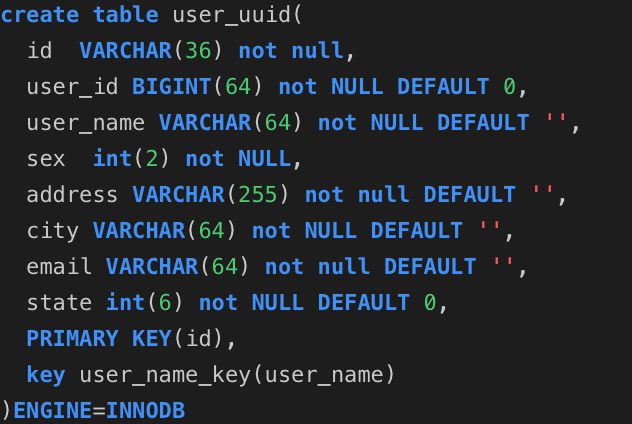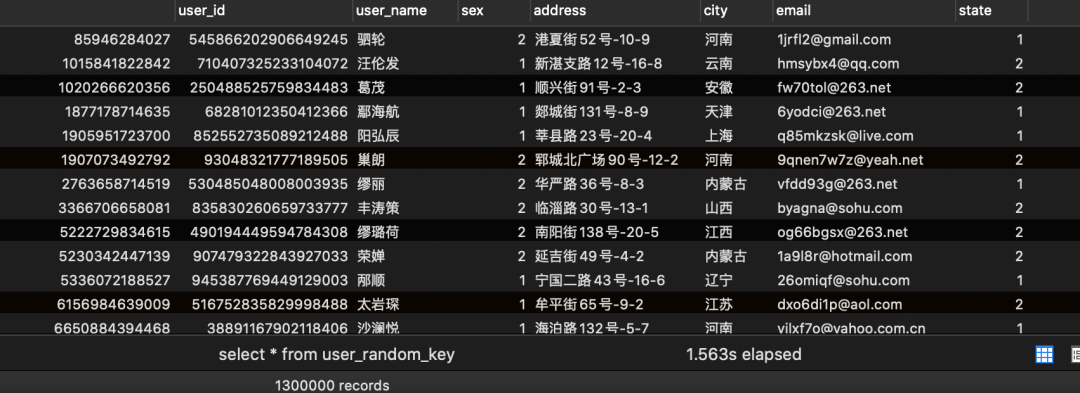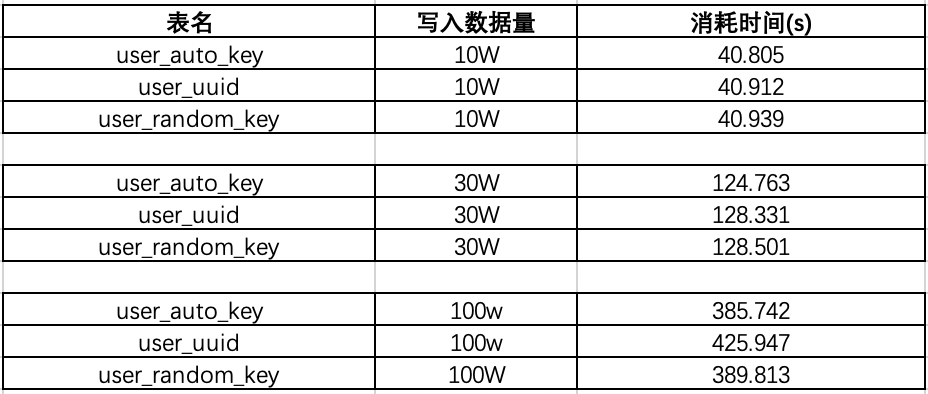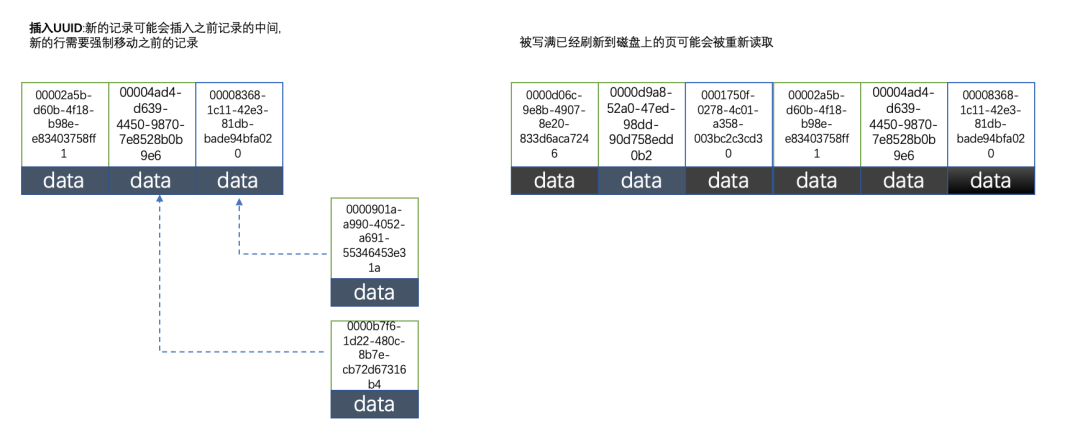MySQL 为啥不能用 uuid 做主键?

来自:博客园(作者:Yrion)
链接:https://www.cnblogs.com/wyq178/p/12548864.html
前言
在mysql中设计表的时候,mysql官方推荐不要使用uuid或者不连续不重复的雪花id(long形且唯一,单机递增),而是推荐连续自增的主键id,官方的推荐是auto_increment,那么为什么不建议采用uuid,使用uuid究竟有什么坏处?
本篇博客我们就来分析这个问题,探讨一下内部的原因。
本篇博客的目录
mysql程序实例 使用uuid和自增id的索引结构对比 总结
一、mysql和程序实例
1.1.要说明这个问题,我们首先来建立三张表
注:这里的随机key其实是指用雪花算法算出来的前后不连续不重复无规律的id:一串18位长度的long值



1.2.光有理论不行,直接上程序,使用spring的jdbcTemplate来实现增查测试:
package com.wyq.mysqldemo;
import cn.hutool.core.collection.CollectionUtil;
import com.wyq.mysqldemo.databaseobject.UserKeyAuto;
import com.wyq.mysqldemo.databaseobject.UserKeyRandom;
import com.wyq.mysqldemo.databaseobject.UserKeyUUID;
import com.wyq.mysqldemo.diffkeytest.AutoKeyTableService;
import com.wyq.mysqldemo.diffkeytest.RandomKeyTableService;
import com.wyq.mysqldemo.diffkeytest.UUIDKeyTableService;
import com.wyq.mysqldemo.util.JdbcTemplateService;
import org.junit.jupiter.api.Test;
import org.springframework.beans.factory.annotation.Autowired;
import org.springframework.boot.test.context.SpringBootTest;
import org.springframework.util.StopWatch;
import java.util.List;
@SpringBootTest
class MysqlDemoApplicationTests {
@Autowired
private JdbcTemplateService jdbcTemplateService;
@Autowired
private AutoKeyTableService autoKeyTableService;
@Autowired
private UUIDKeyTableService uuidKeyTableService;
@Autowired
private RandomKeyTableService randomKeyTableService;
@Test
void testDBTime() {
StopWatch stopwatch = new StopWatch("执行sql时间消耗");
/**
* auto_increment key任务
*/
final String insertSql = "INSERT INTO user_key_auto(user_id,user_name,sex,address,city,email,state) VALUES(?,?,?,?,?,?,?)";
ListinsertData = autoKeyTableService.getInsertData();
stopwatch.start("自动生成key表任务开始");
long start1 = System.currentTimeMillis();
if (CollectionUtil.isNotEmpty(insertData)) {
boolean insertResult = jdbcTemplateService.insert(insertSql, insertData, false);
System.out.println(insertResult);
}
long end1 = System.currentTimeMillis();
System.out.println("auto key消耗的时间:" + (end1 - start1));
stopwatch.stop();
/**
* uudID的key
*/
final String insertSql2 = "INSERT INTO user_uuid(id,user_id,user_name,sex,address,city,email,state) VALUES(?,?,?,?,?,?,?,?)";
ListinsertData2 = uuidKeyTableService.getInsertData();
stopwatch.start("UUID的key表任务开始");
long begin = System.currentTimeMillis();
if (CollectionUtil.isNotEmpty(insertData)) {
boolean insertResult = jdbcTemplateService.insert(insertSql2, insertData2, true);
System.out.println(insertResult);
}
long over = System.currentTimeMillis();
System.out.println("UUID key消耗的时间:" + (over - begin));
stopwatch.stop();
/**
* 随机的long值key
*/
final String insertSql3 = "INSERT INTO user_random_key(id,user_id,user_name,sex,address,city,email,state) VALUES(?,?,?,?,?,?,?,?)";
ListinsertData3 = randomKeyTableService.getInsertData();
stopwatch.start("随机的long值key表任务开始");
Long start = System.currentTimeMillis();
if (CollectionUtil.isNotEmpty(insertData)) {
boolean insertResult = jdbcTemplateService.insert(insertSql3, insertData3, true);
System.out.println(insertResult);
}
Long end = System.currentTimeMillis();
System.out.println("随机key任务消耗时间:" + (end - start));
stopwatch.stop();
String result = stopwatch.prettyPrint();
System.out.println(result);
}
1.3.程序写入结果



1.4.效率测试结果


二、使用uuid和自增id的索引结构对比
2.1.使用自增id的内部结构

2.2.使用uuid的索引内部结构

因为uuid相对顺序的自增id来说是毫无规律可言的,新行的值不一定要比之前的主键的值要大,所以innodb无法做到总是把新行插入到索引的最后,而是需要为新行寻找新的合适的位置从而来分配新的空间。
这个过程需要做很多额外的操作,数据的毫无顺序会导致数据分布散乱,将会导致以下的问题:
①写入的目标页很可能已经刷新到磁盘上并且从缓存上移除,或者还没有被加载到缓存中,innodb在插入之前不得不先找到并从磁盘读取目标页到内存中,这将导致大量的随机IO
②因为写入是乱序的,innodb不得不频繁的做页分裂操作,以便为新的行分配空间,页分裂导致移动大量的数据,一次插入最少需要修改三个页以上
③由于频繁的页分裂,页会变得稀疏并被不规则的填充,最终会导致数据会有碎片
在把随机值(uuid和雪花id)载入到聚簇索引(innodb默认的索引类型)以后,有时候会需要做一次OPTIMEIZE TABLE来重建表并优化页的填充,这将又需要一定的时间消耗。
结论:使用innodb应该尽可能的按主键的自增顺序插入,并且尽可能使用单调的增加的聚簇键的值来插入新行
2.3.使用自增id的缺点
附:Auto_increment的锁争抢问题,如果要改善需要调优innodb_autoinc_lock_mode的配置
三、总结
本篇博客首先从开篇的提出问题,建表到使用jdbcTemplate去测试不同id的生成策略在大数据量的数据插入表现,然后分析了id的机制不同在mysql的索引结构以及优缺点,深入的解释了为何uuid和随机不重复id在数据插入中的性能损耗,详细的解释了这个问题。
在实际的开发中还是根据mysql的官方推荐最好使用自增id,mysql博大精深,内部还有很多值得优化的点需要我们学习。
推荐阅读
